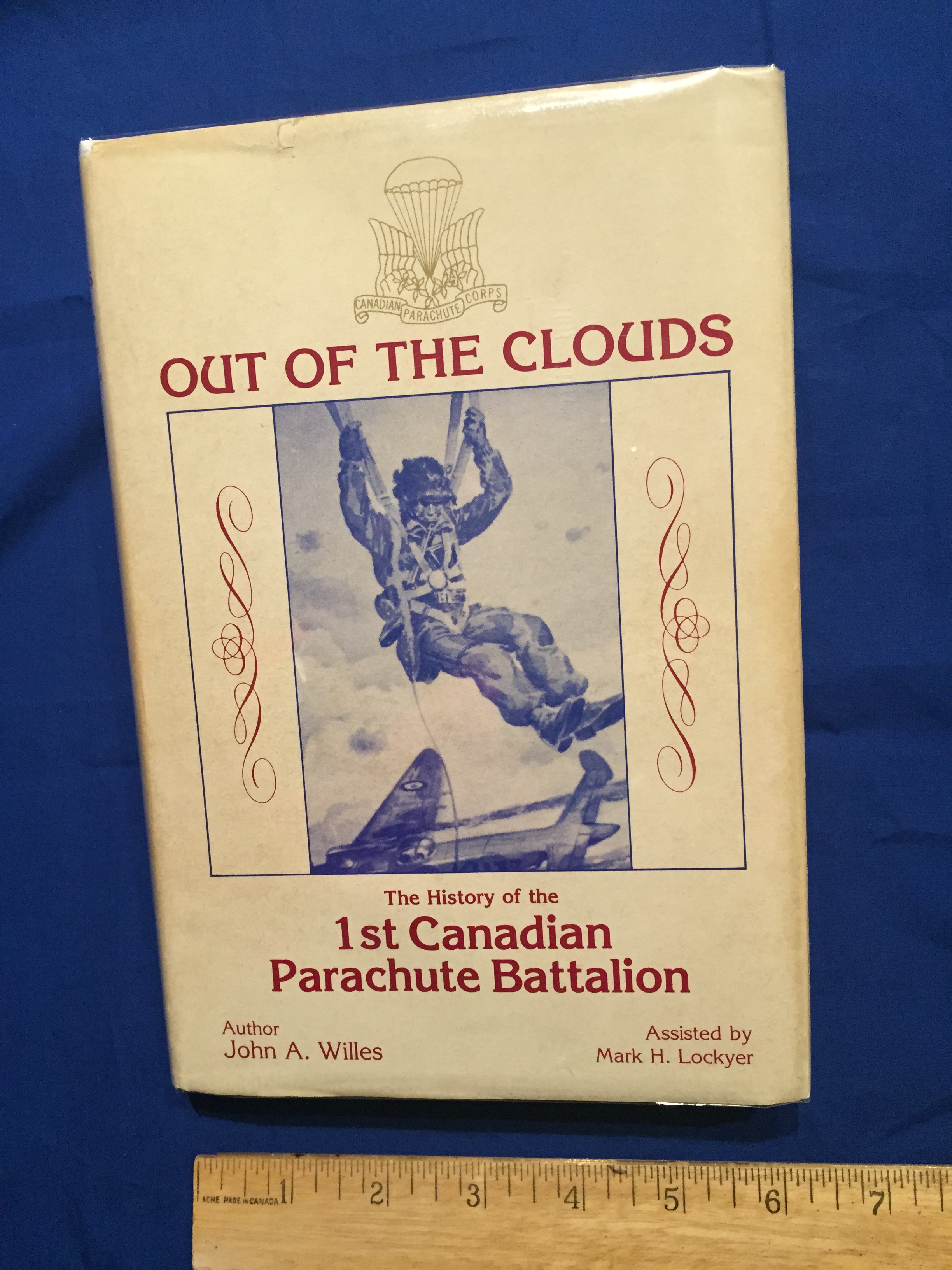
1 Canadian Parachute Battalion was authorized on Canada’s birthday in 1942, on July 1st. Originally slated as a mobile home defense parachute unit, the Battalion was redesignated for overseas. Initial parachute training had been done at Fort Benning, Georgia. Many were also trained at Shilo Manitoba and Ringway in England. The battalion served honourably in Canada, the UK and operationally as part of the British 6th Airborne Division. They were among the first to land on D-Day (1944-06-06 in Normandy, France), fought in the Battle of the Bulge, fought on the Mass River, parachuted into Germany in March 1944 and advanced to Wismar where 6 AB Division stopped the Soviets from illegally occupying Denmark. The Battalion was disbanded in 1945.
WWII 1 Canadian Parachute Corps officer’s cap badge made by Scully Ltd. in Canada. The officers’ had a bi-metallic silver & brass larger badge. On the back of this version of the officers’ cap badge. There are two screw posts. The “nuts” are shown. The “teeth side goes towards the cloth. Some are marked: MONTREAL / STIRLING Not all original officers’ badges have these markings, but the markings are a nice feature.
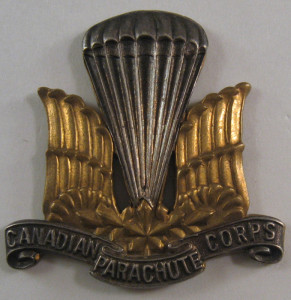
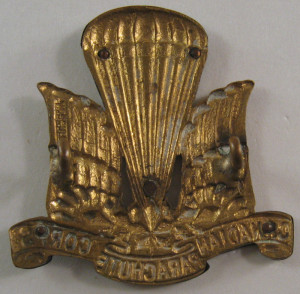
Late in the war some stamped officers’ badges were made.
CAUTION: There are many fake badges on the market. The large white-metal stamped badges with slider tang are fantasy badges that never existed. They were made in the 19770s and sold for GBP 2 each.
In 1945 on the return of 1 Can Para Bn to the UK the small brass cap badges were issued to the Other Ranks. Private Frank Mowat of C Coy recalls each man was issued one, then as a few were left over, these were thrown into the air and a free for all ensured. Some men such as Frank Mowat never switched over to the brass badge – in his case the plastic one was — and still is — HIS.
Interview with Frank Mowat at his home in British Columbia, Summer 1998.
[INSERT PHOTO]
Other Ranks plastic cap badge.
WARNING: These are fragile. The first one I bought arrived broken in the mail. Rare.
Back of Other Ranks’ cap badge. There was originally a matching plastic pin to attach it to the maroon beret.

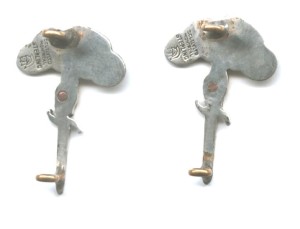
The above badges are from the Colin Stevens Collection.
//
Doug Morrison in jump boots.jpg (227408 bytes)
Doug Morrison on 2 weeks leave after graduating from jump school in Fort Benning, Georgia. 1942-43. Note the wedge cap (pre-maroon beret), Canadian jump wings and lanyard. The lanyard appears to be two colours. Doug remembers it as being yellow. (Photo copyright Doug Morrison ex-B Coy, then Vickers platoon, HQ Coy, 1 Cdn Para Bn.. 1942-45.)
//
Jump tower Shilo 1985.jpg (106705 bytes)
Jump tower at CFB Shilo, Manitoba, Canada in October 1985. Veterans have told me this tower was demolished shortly after this photo was taken. – Photo by Colin Stevens
1 CPB 1st parachute jump in Canada from Lodestar.jpg (70407 bytes)
First official paratroop jump in Canada from
Lockheed Lodestar near Shilo, Manitoba.
Bradbrooke__Griffin.jpg (22473 bytes)
Lt. Col. Bradbrooke and Major Griffin. The photo was taken before D-Day, probably in England in 1943. The CO is on the left and is wearing the British cloth covered rubber training parachuting helmet, and 1942 Pattern “jacket, parachutist’s” (sleeveless smock) over his battledress. His shoulder title is the AIRBORNE CANADA early type. major Griffin is wearing his maroon beret with the bi-metallic heavy officer’s cap badge (silver & brass). As an officer he is wearing his battledress blouse open at the neck, with a tie. Note his parachute badge on his leaf breast. Both men are wearing the British parachutes with the quick release box (turn about 1/4 turn in direction of arrow and then pound with your fist or palm to release three of the four straps). Note that there is no reserve parachute. (Photo copyright Doug Morrison ex-B Coy, then Vickers Platoon, HQ Coy, 1 Cdn Para Bn. 1942-45.)
Padre Harris & Brig Hill.jpg (64648 bytes)
Padre Harris & Brigadier James Hill
Padre Harris with turkey & Private Rodrique.jpg (82765 bytes)
Padre Harris & Pte. Rodrique
Welbike Sgt Gordon Davies 1 Can Para Bn 1944 01 05 DND27889.jpg (54891 bytes)
Sgt. Gordon Davies 1 1 Canadian Parachute Battalion
on a Welbike in England, January, 1944.
The battalion jumped into battle at night on D-Day June 5/6 1944 as part of the 3rd Parachute Brigade of the British 6th Airborne Division. They stayed in the line for some time and suffered many casualties. They were withdrawn to England for rest and replacement of casualties.
Their next combat mission was by sea and land to help stop the German breakthrough in the Ardennes (“Battle of the Bulge”) in December 1944.
Section of camouflaged British parachute that Pte. Verne Haughian, Signaller, HQ Coy 1 Cdn Para Bn. picked up on the drop zone for Operation
Varsity in Germany, March 1945. He used this section to line his trenches. Photo by Colin Stevens.
The battalion parachuted across the Rhine River into Germany in Operation Varsity in March 1945. They then participated in the race to the Baltic and eventually reached Wismar, just before the Soviets did.
convoy_3.jpg (39262 bytes)
“Prisoners coming in” Germany Spring 1945. Photo taken from one of the vehicles in the 1 Cdn Para Bn’s convoy. Click on image for larger photo. (Photo copyright Doug Morrison ex-B Coy, then Vickers Platoon, HQ Coy, 1 Cdn Para Bn. 1942-45)
The jeep in the background is British airborne modified (weapons clips in front of the windshield, modified front bumper etc. The spare tire cradle is in place on the front, but no spare wheel is mounted there in this photo.). The jeep has a round bridge plate over the right (starboard) headlight location, and a formation sign (Pegasus and Bellerophon) divisional sign on a plate attached to the grill to left (port) of centre. The cap badge of the driver appears to be the Parachute Regiment, so the jeep is from one of the other units in the 6th Airborne Division. (Photo copyright Doug Morrison, ex-B Coy & later Vickers Platoon, HQ Coy, 1 Cdn Para Bn. 1942-45.)
1 Canadian Parachute Battalion was returned to Canada in June 1945 and after some parades was disbanded. The members dispersed across Canada to their homes.
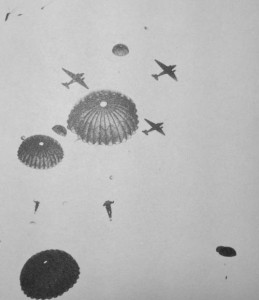
1 Canadian Parachute Battalion Training Company existed in England during the war to train reinforcements for 1 Cdn Para Bn.
A training school was operated at Shilo, Manitoba during and after the war.